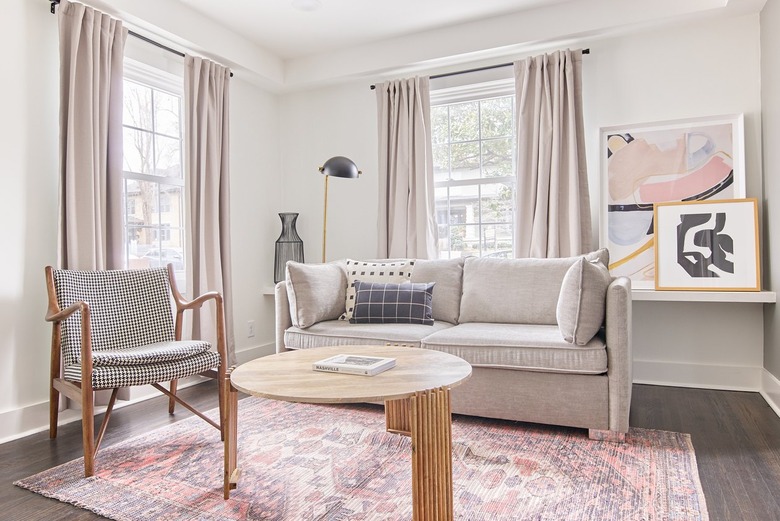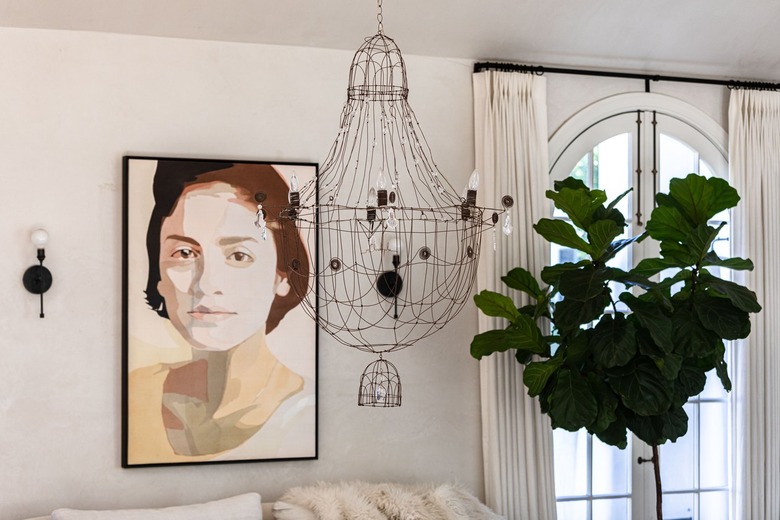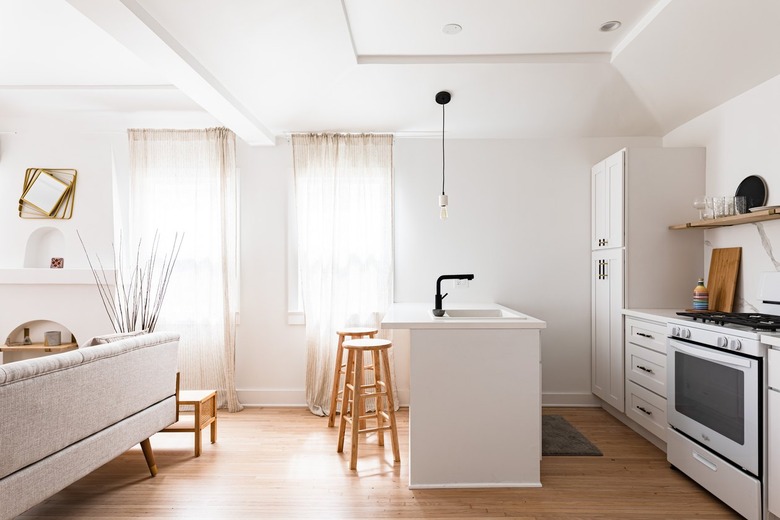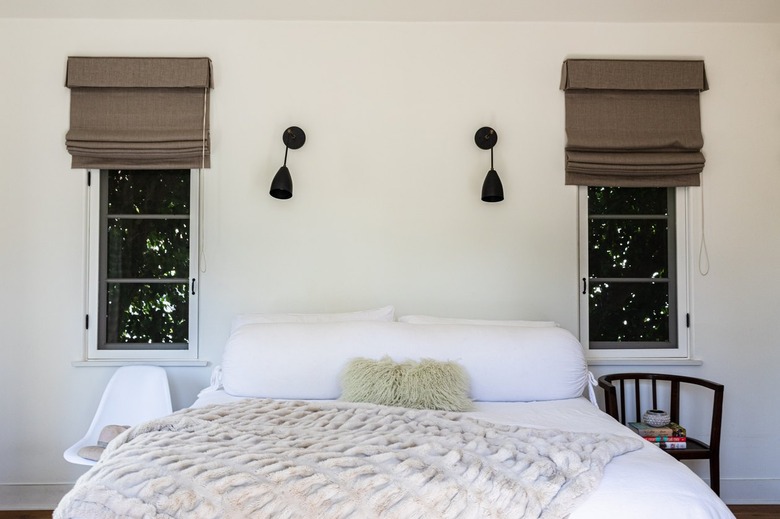The Ultimate Guide To Window Treatment Costs
When you decide to buy new window treatments for your home, creating a budget seems like a no brainer. The only problem? It's very hard to find valid pricing information on curtains, drapes, blinds, and shades because there are so many different factors that go into the cost — including window size, installation method, materials, quality, and whether or not the products are custom made.
Luckily, we've dug into finding exactly what window treatments cost so you can determine exactly what to spend on each room or area of the house.
Window Size Matters
Window Size Matters
The biggest factor behind the differing costs of window treatments is simply the size. Naturally, a café curtain that's only 24 x 24 inches will cost far less than a curtain made of the same material but designed for a 72 x 80-inch sliding glass door.
The increase in price is not only related to the cost of the window coverings themselves but also the hardware, since larger windows often require sturdier materials to support the window treatment. As an example, when using a curtain rod to support draperies on windows over 72 inches, you will need an additional support bracket for every 36 inches of length.
The Cost of Installation
The Cost of Installation
Installing most types of window treatments is a fairly simple process — so simple, in fact, that professionals will only need around 30 minutes to install any type of window covering. On average, the cost of labor for professional installation of window coverings is around $35 to $100 per hour, which comes out to an average price of $17.50 to $50 per window, or $140 to $400 for eight windows. Keep in mind that most pros will have a minimum fee per visit, so expect to pay at least $50, even if you're only installing one or two windows.
Because window treatments tend to be fairly simple to install, many homeowners choose to DIY the project. Since most window treatments typically require just a few tools and an hour or less, this is a practical option. Overall, horizontal blinds, cellular shades, Roman shades, curtains, and drapes are the easiest window treatments to install, followed by roller shades, solar shades, and sheer shades. Vertical blinds, panel blinds, and traverse rods for draperies, on the other hand, are the most time consuming because they can be heavy and frustrating and may require a ladder, but these are still very doable for most homeowners.
Specialty techniques are required to install window treatments on windows with arches, corner windows, angle-top windows, bay windows, or windows surrounded by tiles, so these jobs may be best left to the pros. Because these jobs are more complex, the installation will usually take longer than a standard window treatment installation, meaning professional installation will be more expensive — often double the cost of a standard installation due to the increased time commitment.
What About Materials and Hardware?
What About Materials and Hardware?
Window treatments are made from a wide array of materials. Curtains, drapes, and shades are typically made from different fabrics, including polyester, acrylic, cotton, vinyl, woven wood, linen, rayon, silk, wool, velvet, brocade, and cashmere. Naturally, some materials cost more than others. For example, cotton costs $5 to $20 per yard, whereas silk can be anywhere from $7 to $60 per yard, and cashmere can easily cost over $100 a yard.
Blinds are more commonly made from hard materials, such as PVC, vinyl, aluminum, faux wood, and real wood, but they may also be made from thick fabrics, typically cotton. On the low end of the price spectrum are PVC, vinyl, and aluminum. Real wood and cotton are pricier.
Specialized hardware can also add a premium to your total costs. For example, drapery installed with a dramatic sconce, decorative curtain rod, and elaborate finials will cost far more than curtains installed on a low-priced tension rod. Similarly, if you choose to install a motorized curtain rod, electric shades, or automatic blinds, these upgrades are certain to add a premium to your overall price — often twice the price or more of manually operated window coverings. Motorized options are well worth it for particularly large windows and those that are hard to reach as well as for homeowners who have mobility issues and can't easily open their window coverings manually.
Quality Is Important
Quality Is Important
Always consider how long your materials will last. If you want to change window treatments regularly to keep up with current trends, then low-quality materials aren't really a problem. If you want your window coverings to last for a long time, consider a material that will hold up well for years to come, even if it may cost more in the short term. For shades, this could mean choosing woven wood, which is a particularly sturdy material. For curtains and draperies, all linen or linen blended with rayon is particularly durable. When it comes to blinds, faux wood holds up better than vinyl and aluminum and is impervious to moisture and humidity, unlike real wood.
Off the Shelf vs. Custom Made
Off the Shelf vs. Custom Made
It shouldn't be too surprising that custom-made products will cost more than those bought off the shelf. This expense may not be worth it for the average homeowner, but if you have a uniquely shaped window or you're looking for a very specific (and uncommon) fabric, color, or pattern, this could be your only realistic option to meet your exact specification.
Even if you have a uniquely shaped window, you might not need to pay the full expense to have fully custom-made curtains. You may be able to purchase curtains that are a little too large and then simply have them hemmed to fit. In fact, the average cost to shorten a lined panel is $25, and for an unlined panel, it is around $18. Compare that to the labor charge for custom curtains, which can easily cost upward of $100 per panel plus the actual cost of the materials.
Curtains and Drapes
Curtains and Drapes
Size and material are the two factors that have the biggest influence on a curtain's price. A 48 x 84-inch polyester curtain panel will have an average cost of anywhere from $10 to $25, whether it is designed to be light filtering or blackout. For a similarly sized curtain in cotton, the price will increase to around $15 to $60 per panel. Adding a layer of thermal insulation, which can increase the energy efficiency of the curtain, may increase the cost a little, so expect a similar-size polyester panel made with insulation to cost between $20 and $40.
While drapes are similar to curtains, they are longer and heavier, meaning they are also typically more expensive since they tend to involve more fabric and more luxurious materials. A velvet drapery in a comparable size would be anywhere from $150 to over $1,000. This is why formal drapes are typically reserved for the living room or dining room, where guests are most likely to see and appreciate these extravagant additions to your home's décor.
Custom drapes can be particularly pricey, ranging from $250 to $1,500 per panel depending on the size, material, and intricacies of the design. While many people prefer the fullness of heavily pleated drapes, these details will add a bit to the price of your custom window treatment because they will take your tailor more time and will require more material. To put things in perspective, a basic pencil pleat might cost $100 per panel in labor, while a triple pleat will cost nearly $200 in labor and require 50 percent more material.
When pricing curtains and drapes, also remember the cost of the hardware. While an inexpensive 48- to 84-inch lockseam curtain rod may be found for anywhere between $10 and $20, a more high-quality rod in the same size range that offers a little more visual appeal will typically run from $50 to $100, and a decorative curtain rod of the same size will usually cost over $100. Expect to pay more for specialized brackets, sconces, or finials.
Average Cost of Blinds
Average Cost of Blinds
Estimating how much window blinds cost is particularly difficult because there are so many different types of blinds. Miniblinds, Venetian blinds, and vertical blinds each have their own price ranges, varying based on material and size. Miniblinds, which have slats between 1/2 and 1 inch wide, are typically the cheapest type of blinds and are typically made from vinyl or aluminum. Vinyl miniblinds sized 47 x 48 inches will cost between $30 and $35, while the same size blinds in aluminum cost between $35 and $55.
Venetian blinds, which have wider horizontal slats than miniblinds, come in more materials but are most commonly sold in faux wood or real wood materials (though real wood products typically need to be custom ordered to fit). Whereas faux wood blinds with 2-inch slats may cost around $45 to $60 for a 47 x 48-inch set, custom blinds made from wood that are ordered from major retailers rather than specialty companies will cost around $125 to $200 for the same size options.
Vertical blinds are the most common option for longer windows because they are easy to use and are inexpensive, and they provide excellent light control. Like other common window treatments, the biggest factors in the price are materials (typically PVC or fabric) and size. PVC is the most common material for these blinds, and a typical set of PVC vertical blinds for a sliding glass door measuring 72 x 80 inches will range between $30 and $70. Fabric vertical blinds in the same size range from $180 to $300.
Pricing for Window Shades
Pricing for Window Shades
The three most common shades are Roman shades, roller shades, and cellular shades. Cordless Roman shades will run from around $55 to $75 whether they are light filtering or blackout, but expect to pay more for specialty products sold by designer studios. Some companies, like Home Depot, offer semicustom shade options that cost between $120 and $480.
Because Roman shades can add an elegant touch to the room, people often order them fully customized in the homeowner's choice of luxury fabrics, but because the mechanics of these shades are more intricate than curtains, the labor cost is more expensive. The labor for a 46.5 x 48-inch Roman shade is around $110 plus the cost of the fabric. Expect to pay more for additional details, such as beads, roping, contrast edging, or dramatic balloon-style gathering.
Roller shades are the less formal cousins of Roman shades since they have a similar functionality but a more casual style when they're raised. Typical prices for off-the-shelf models around 46 to 48 inches wide and up to 72 inches long are $25 to $75. These can frequently be cut to the width of your window, and they can be longer than the window itself since you can simply pull them as far down as you want or shorten them. Because the mechanics and details of roller shades are less complicated than Roman shades, semicustom designs from major retailers are available for $44 to $200.
Cellular shades, sometimes known as honeycomb shades, are typically made from polyester and are priced not only based on their size but also on how many layers of cells are in the window treatments, ranging from one to three. The more cells in the shades, they better they insulate your home. Single-cell shades that are 48 inches wide may cost between $40 and $140, whereas double-cell shades of the same size range from $63 to $140. Triple-cell shades are more rare and will typically cost upward of $100. Like roller shades, these are often made to be trimmed to fit your window.



